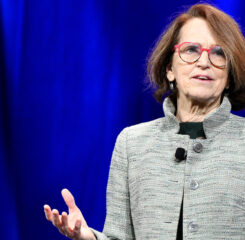What if someone told you that in five years your organization will be at the vortex of an emerging age-centered economy? That half of your workforce will be supplemented with artificial intelligence, government-funded family caregivers, and staff outside your current business lines? That older adults will be working in an on-demand, flexible workforce, and older entrepreneurs will abound? That nearly all care and services for older people will be delivered in community-based dwellings?
If someone told you these realities are on our horizon, you might say, “how do you know that?!” The answer: strategic foresight is signaling the way.
By regularly scanning for trends and emerging issues, and forecasting their implications, we can plan a strategic response. That’s how we build strong organizations that better serve tomorrow’s older adults.
First, some definitions. Strategic foresight means anticipating change we might see in the future so that we can plan and take strategic action now. It involves looking beyond near-term trends —which are a playing out of what has happened in the past—to explore emerging issues—which are changes that might occur in the future.
This is about anticipation not prediction, because emerging issues are less certain than near-term trends. But by reflecting on and prioritizing the factors that could have an impact on the field and your organization, you can envision how alternative futures might unfold— and work to advance a future that best supports your mission and sustainability.
As a leader in our sector, you know that emerging issues are rarely interpreted for older adults’ housing, care, and services. LeadingAge is trying to change that for our members. We’ve developed a resource that regularly scans emerging issues and interprets them for the field. That means members like you can incorporate these insights into more future-informed visions and decisions. Learn how and access a regularly updated set of emerging issues with the Learning Hub – LeadingAge Governance Resources.
Want a head start? Here are a just a few emerging issues that might lead your organization to develop surprising strategic actions that positively impact us all.
- Emerging Tools to Address Physical, Mental, Emotional-Social Health Needs and Demands: Anticipate radically different tools to meet evolving needs of a growing older population, including AI/robotics, improved prognostic and precision medicine, mental health interventions, blanket vaccines, personal monitoring devices, brain health interventions, and social connection opportunities.
- Home-First, Whole-System, Closed Loop, Integrated Life Spaces and Connections: Targeting, integrating, coordinating, and packaging comprehensive support across sectors, settings, and partners with aligned interests and in virtual and physical spaces could be imperative to meet the emerging needs and demands of older adults. Increasingly advanced-care and support—including mental health interventions– offered wherever a person calls home is the norm.
- Older-Adult Centered Economies and Infrastructure: The aging population brings engaged, productive older consumers who have unique needs/wants, resources, and are proven drivers of economic growth. This will catalyze responsive innovations around transportation, work, connectivity, caregiving, and environments that are centered on older adults yet bring universal benefit to all.
- Potpourri of Housing Approaches: While existing affordable housing stock appears insufficient to meet future needs, evolving affordable housing options (container, tiny, 3-D printed housing), may assist older adults in staying in community.
- Human + Technological Workforce: The nature of work, learning, and training could shift dramatically via concurrently hiring, educating, and training workforce in-house, emerging care workforce cooperatives within a broader caring economy, family caregiver public subsidies, and emerging human caring replacement technologies.
- Sustained Equity and Population-Based Health Efforts: Assuring equity and health of populations will require intensified and sustained efforts that recognize and accommodate diversity, acknowledge, address, and repair racism and other forms of systemic bias, and seek community and population-level approaches to equitable health and well-being.
Today’s environment requires all our organizations to move away from defensive reactions to the rapidly shifting influences around us. It’s time to invest in the innovative, strategic responses that put us on a course toward a stronger future.
Olivia Mastry transitioned her nonprofit strategy and governance consultancy in 2010 to found Collective Action Lab to support nonprofit organizations in the areas of health, well-being, aging, disability, and equity transformation, as well as organizations collaborating to accomplish social and systems change goals that they could not achieve alone. Olivia combines her training and experience in law, health administration, public health, and trauma-informed conflict resolution to support collaborators in accelerating and realizing their visions. Olivia received the 2015 Public Health Innovator Award by the University of Minnesota School of Public Health and was named the 2016 Gerontologist of the Year by the Minnesota Gerontologist Society. View her resume. Contact LeadingAge to be connected to Olivia.

 Shutdown Week Three: Impact of Ongoing Closure on Affordable Housing
Shutdown Week Three: Impact of Ongoing Closure on Affordable Housing


